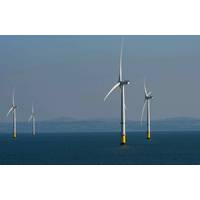Navy Tests 100-percent Advanced Biofuel
Secretary of the Navy Ray Mabus' energy vision came to fruition in September when the EA-18G "Green Growler" completed flight testing of a 100-percent advanced biofuel at Naval Air Station Patuxent River, Maryland.
"From takeoff to landing, you couldn't tell any difference," said Lt. Cmdr. Bradley Fairfax, project officer and test pilot with Air Test and Evaluation Squadron (VX) 23, after the first test flight Sept. 1. "The information presented to us in the airplane is pretty simplified but, as far as I could tell, the aircraft flew completely the same as [petroleum-based] JP-5 for the whole flight."
Using the Naval Air Warfare Center Aircraft Division's (NAWCAD) Real-time Telemetry Processing System (RTPS) at the Atlantic Test Ranges, flight test engineer Mary Picard monitored the ground and test flights and confirmed Fairfax's observations. "What we have seen is that the 100-percent bio-JP-5 appears to be basically transparent. It looks just like petroleum JP-5 in the airplane. So far, everything looks good and we haven't noticed a difference."
And that's the technical premise of the Navy's alternative fuels test and qualification program: the JP-5 produced from alternative sources must be invisible to the user, said Rick Kamin, energy and fuels lead for Naval Air Systems Command (NAVAIR). Kamin also leads the alternative fuel test and qualification program for the Navy.
The catalytic hydrothermal conversion-to-jet (CHCJ) process 100-percent alternative fuel performed as expected during a ground test Aug. 30 at NAWCAD's Aircraft Test and Evaluation Facility (ATEF), followed by the first test flight Sept. 1, Kamin said.
"Today is a further example of how the Navy and Marine Corps continue to lead in energy innovation and, in doing so, remain the greatest expeditionary fighting force the world has ever known," said Mabus.
The fuels program supports SECNAV's operational energy goal to increase the use of alternative fuels afloat by 2020.
"As the owner of the JP-5 aviation jet fuel specification, our job at NAVAIR is to make sure that whatever source our JP-5 is made from, we know it will work in our aircraft," said Kamin.
"This is the first time we've looked at a process that can produce a fuel with all the properties and chemistry of JP-5 jet fuel without having to blend with petroleum based JP-5," said Kamin.
CHCJ, the 100-percent drop-in renewable jet fuel tested, is produced by Florida-based Applied Research Associates (ARA) and Chevron Lummus Global. ARA's process uses the same feedstocks as the Hydroprocessed Esters and Fatty Acids (HEFA) 50-percent advanced biofuel blend previously approved by the Navy, but goes through a unique conversion process that provides a fully synthetic fuel that does not need to be blended, Kamin said.
"We are excited to work with the U.S. Navy as it takes this important step toward the use of 100-percent drop-in renewable jet and diesel fuels in its aircraft and ships," said Chuck Red, vice president of fuels development for ARA. "Our renewable fuels continue to prove their viability as 100-percent replacements for petroleum in diesel and jet fuel applications."
The fuels team has evaluated five alternative sources for JP-5 and four F-76 sources since SECNAV kicked-off the program in 2009. The team, however, was already researching advanced biofuels in response to interest from the U.S. Air Force and the commercial airline industry in 2008.
"We shot for this 100-percent drop-in fuel from the beginning," Kamin said. "We wanted to know if a fully synthetic JP-5 from a non-petroleum source could work in our systems and we proved that it could!"
Benefits of Alternative Fuels
"This is a continuation of a long Navy tradition," Mabus said. "In the middle of the 19th century, we went from sail to coal. In the early 20th century, we moved from coal to oil. In the middle of the 20th century, we pioneered nuclear as a propulsion method. Every single time we moved to a new form of power, as we are doing now with alternative fuel, people had doubts; and every single time they were wrong."
A 100-percent alternative helps with procurement and logistics, Kamin said. A blend requires the biofuel manufacturer to blend its biofuel with a petroleum-based JP-5 to produce an on-specification product, which requires more time and additional facilities, all with a higher cost.
"Having our platforms certified to operate on 100-percent alternative fuels gives us flexibility and, in the end, gives us both a strategic and combat advantage," Mabus said. "It gives us options; options which are important now and will remain important in the future," he added.
"And we're not alone," Mabus said. "The commercial sector is also working hard to incorporate alternative fuels into their supply chains, which will only increase our operational flexibility."
The Navy fuels team is collaborating with commercial activities such as the American Society for Testing and Materials (ASTM), the owner of commercial fuel specifications and the Commercial Aviation Alternative Fuels Initiative (CAAFI), which seeks to enhance energy security and environmental sustainability for aviation through jet fuel produced from alternatives to petroleum, Kamin said.
For example, General Electric, which makes the engines for the F/A-18, also makes engines for commercial aircraft. "It's a big community of military and commercial activities sharing information and working together to make sure that everyone has what they need to allow qualification to proceed," Kamin said. "We, the Navy, are a customer and our role is to qualify processes that we can use, regardless of where the fuel source originated."
